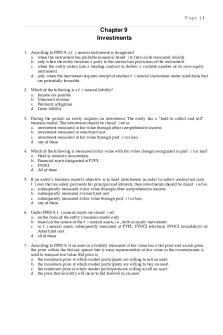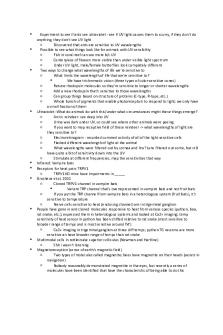Astro Lecture 9-10 - Venus, Mars, Jupiter with Professor Arias PDF

| Title | Astro Lecture 9-10 - Venus, Mars, Jupiter with Professor Arias |
|---|---|
| Author | Maritza Nat |
| Course | Planetary Astronomy |
| Institution | Santa Monica College |
| Pages | 4 |
| File Size | 42.1 KB |
| File Type | |
| Total Views | 136 |
Summary
Venus, Mars, Jupiter with Professor Arias...
Description
July 2019
Lecture 9&10
Venus ➔ Dry Hot surface ➔ Rotates slowly backwards ➔ Profile: ● Rotates once every 243 Earth Daysand retrogrades to most all other planets. ● East to West ● Orbital period : 224.7 days ● Average distance: .723 AU ● Surface Temperature: +470 Degrees Celsius ➔ Interior: ● Density is slightly less than Earth ● Density and size of Venus indicates that is has a dense metallic interior , but no detectable magnetic field ➔ Atmosphere: Mostly acidic, crushing pressure, multiple layers, stable clouds, extremely hot and dry ● Lower atmosphere is much hotter ● 4 main cloud layers plus the haze is what makes the surface invisible but its still thick. ➔ Surface: Early radar revealed mountains, plains and craters
The Venusian Greenhouse ➔ A runaway greenhouse ● CO2 atmosphere is opaque to infrared radiation: surface is hot enough to melt lead ● High winds carry heat uniformly around the planet ● No water to absorb ● No cold side , only heat ● No water.
Map of Venus ➔ Nearly 1000 impact craters on its surface: scattered ➔ Volcanism dominates the surface of Venus: Lava flows cover much of its surface ➔ History of venus : ● Likely once it may have had water then evaporated ● Runaway greenhouse effect ● Low density crust more buoyant than earth ● Crust is not rigid
July 2019
Lecture 9&10
Mars Intermediate Size : half of earth's diameter Thin atmosphere Water found in ice or gas form Profile : ● Average distance from the sun : 1.52 AU ● Orbital Period: 1.88 years ● Period of rotation: 24.62 year ● Axis is titled by 25.2 degrees ● A little atmosphere and contains seasons ➔ Lowell's Mars Globe: this globe showed a network of canals, oases and a transportation system for water. BUT there are no canals on Mars. Canals were an optical illusion. ➔ ➔ ➔ ➔
Interior ➔ No magnetic field ● Has traces of magnetism frozen into some sections of old crust ➔ Tides are less than one centimeter high ➔ Has a dense core , less dense mantle, and a low density crust so it revolves pretty quickly
Atmosphere ● 95% CO2 plus nitrogen and argon ● Water can only exist as ice or vapor ● Density is 1% of Earth
What we know about Mars ➔ Surface: Red Planet , dry rocky, iron rich ● Has weather ● Use to have volcanoes ➔ Missions: Spirit Rover, Pathfinder lander , Sojourner Rover ➔ Craters: Large in canyon sizes ● 800 meters wide ➔ Meteorites: Fragments of the planet that comes off eventually ➔ Mars Map from Laser Ranging: to see contrast of highlands and lowlands ➔ Martian Landslides to look at the terrains ➔ Polar Ice caps: High pressure CO2 gas vaporized by spring sunlight bursts out of the ice in geysers.
July 2019
Lecture 9&10
The Outer Planets , Plus Pluto Atmospheres and Interiors ➔ Belt Zone circulation ● Clouds form dark belts and light zones that circle the planets ● Gaseous ➔ Satellite Systems: ● Regular Satellite: large and orbit close to parent planet ● Irregular: smaller, sometimes have retrograde
Jupiter ➔ Largest and massive planet ➔ Profile: ● Average distance: 5.2 AU ● Orbital period: 11.9year ● Period rotation: 9.92 h ● Inclination of equator to orbit: 3.1 degrees ➔ Interior: Mostly liquid hydrogen containing small amounts of heavier elements Magnetic Field ➔ 14 stronger than Earth ➔ Produced by the dynamo effect operating in the highly conductive liquid metallic hydrogen ➔ Auroras are also present because of this Atmosphere ➔ Clouds confined to a shallow layer ➔ Large spots= circulating storms ➔ Layers of clouds ➔ Great Red Spot: Giant Circulating Storm Moons and Rings ➔ Callisto: Ancient Surface ● Dark surface with many craters ● No metallic core ➔ Ganymede: A puzzling past ● Largest moon in the solar system ● Ice-rich mantle
July 2019
Lecture 9&10
Saturn ➔ Radiates 1.8 times as much energy as it receives from the Sun. ➔ Weaker magnetic field ➔ Saturn's Auroras : rings
Pluto ➔ On the Kuiper Belt ➔ Too small to be considered a planet so it's called a dwarf planet. ➔ Profile: ● Peri-29.658 ● Aphe-49.30 ● Orbital period - 248 yr ● 44K (-380 degree F) ● Axil tilt - 120 degree ➔ Dwarf Planets: too small to clear their orbital zones of other objects...
Similar Free PDFs

910-quiz
- 11 Pages

Astro-draconic - Lecture notes 5
- 3 Pages

Astro ArlinesAssigment1
- 9 Pages

Rubén Darío. Venus
- 3 Pages

Evaluacion NTC 4983 - 910
- 2 Pages

Venus, comentario
- 4 Pages

Astro- Quiz 3 - Lecture notes 26-38
- 23 Pages

catalogue jupiter mx-cw
- 61 Pages
Popular Institutions
- Tinajero National High School - Annex
- Politeknik Caltex Riau
- Yokohama City University
- SGT University
- University of Al-Qadisiyah
- Divine Word College of Vigan
- Techniek College Rotterdam
- Universidade de Santiago
- Universiti Teknologi MARA Cawangan Johor Kampus Pasir Gudang
- Poltekkes Kemenkes Yogyakarta
- Baguio City National High School
- Colegio san marcos
- preparatoria uno
- Centro de Bachillerato Tecnológico Industrial y de Servicios No. 107
- Dalian Maritime University
- Quang Trung Secondary School
- Colegio Tecnológico en Informática
- Corporación Regional de Educación Superior
- Grupo CEDVA
- Dar Al Uloom University
- Centro de Estudios Preuniversitarios de la Universidad Nacional de Ingeniería
- 上智大学
- Aakash International School, Nuna Majara
- San Felipe Neri Catholic School
- Kang Chiao International School - New Taipei City
- Misamis Occidental National High School
- Institución Educativa Escuela Normal Juan Ladrilleros
- Kolehiyo ng Pantukan
- Batanes State College
- Instituto Continental
- Sekolah Menengah Kejuruan Kesehatan Kaltara (Tarakan)
- Colegio de La Inmaculada Concepcion - Cebu







